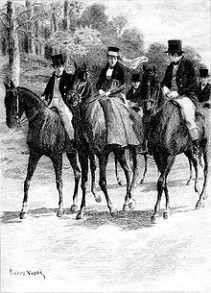
A Murky Business
THE HUMAN COMEDY – Honoré de Balzac XIIth (twelfth) volume of works of Honoré de Balzac edited by widow André Houssiaux, publisher, Hebert and Co, successors, 7 rue Perronet – Paris (1877) Scenes from political life

On the road to Troye
A TENEBROUS AFFAIR Scenes from political life
Analysis and history Une ténébreuse affaire is perfectly in keeping with Balzac’s definition of Scènes de la vie politique. But to understand it, we need to look at the subject and the political circumstances that inspired Balzac. The subject is the story of a miscarriage of justice that was famous in its day, the execution on November 3, 1801 in Angers of two young men, Auguste-Marie du Moustier de Cauchy and his 19-year-old brother-in-law Jean-David-Charles de Mauduison, and their accomplice Etienne Gaudin, condemned by a court of exception for the kidnapping of Senator Clément de Ris. The abduction took place on September 23, 1800. The senator, a well-known political figure, had been kidnapped from his château in Beauvais, near Tours, by five masked strangers, held captive for three weeks and found safe and sound on October 11 by three secret agents sent on a mission by the Minister of Police. Three months later, on January 18, 1801, after an investigation by the political police, Cauchy and Mauduison, former Chouans who had submitted after the Edict of Pacification, were arrested, and on May 11, 1801, their accomplice Gaudin. The trial began in Tours on July 15, 1801, before a “special tribunal”. Senator Clément de Ris had refused to lodge a complaint and also refused to attend the hearing. This absence seemed odd. The “special court” refrained from convicting and asked for further information. This first judgment was overturned by the Cour de cassation. A second trial began before another “special tribunal”, that of Angers, on October 23, 1801, and ended with the three main defendants being sentenced to death. The verdict was delivered on November 2. Under the legislation governing these courts, the sentence was final and not subject to appeal. The young men and their accomplice were executed the following day. This affair had taken place in Tours at a time when Balzac’s father was an important civil servant there, close friends with General de Pommereul, who had just been appointed prefect of the department on February 27, 1801. It’s almost certain that Balzac knew details from his father and General de Pommereul that had not been revealed to anyone else. Some of these facts were made public in 1828 in the Memoirs of the Duchesse d’Abrantès, Balzac’s mistress at the time and probably the source of his information. These are the circumstances. And here’s what Balzac did with it. He constructs a drama in three episodes. In the first, the de Simeuse twins, emigrants belonging to Condé’s army and owners of a huge estate confiscated and sold as “national property”, have secretly crossed the border to become involved in a conspiracy to be hatched in Paris. The conspiracy is discovered, and they are surrounded in the Nodesme forest, part of their ancient estate, but they manage to escape thanks to their cousin Laurence de Cinq-Cygne and the former gamekeeper of their estate, Michu, who is secretly devoted to them. Date of this first episode: September 1803.
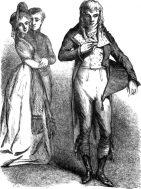
Corentin
The second episode recounts the kidnapping of Senator Malin de Gondreville, copying the main circumstances of the kidnapping of Senator Clément de Ris. Date of this episode: the night of mid-Lent, 1806. This kidnapping is the revenge of policeman Corentin, who was played by Laurence de Cinq-Cygne and Michu during the Simeuse escape. Coincidentally, the de Simeuse and Michu twins have no alibi for the night of the kidnapping. That night, they were repatriating the Simeuse fortune that Michu had hidden in the woods when the Simeuse parents were arrested and the twins fled. Details such as giving all the servants the day off for mid-Lent (so they could transfer the treasure incognito) raise suspicions. They are arrested and accused of kidnapping the senator. The third episode is the trial of the de Simeuse and Michu twins. Trial date: April 1806. Balzac combines the two real-life drama trials into a single one, spread over two days. A dramatic turn of events leads to the jury’s vote: the senator appears as a witness in court and confirms that the person who came to feed him in the retreat where he was imprisoned is none other than Michu’s wife, Marthe. During an exchange of words while receiving food from his captors, he recognized her voice. Marthe has been lost to the scheming of Fouché’s secret agent, Corentin, who, to serve the interests of the government, blames the Simeuse family for the plot arranged by him with the support of Police Minister Fouché. The de Simeuse twins were sentenced to twenty years in prison, while Michu, overwhelmed by public prejudice, was condemned to death. Laurence de Cinq-Cygne asks the Emperor to pardon the twins she snatches from him on the battlefield on the eve of the Battle of Jéna. But the emperor promises nothing for Michu, whom Laurence thought would be saved like the others, and who is guillotined.
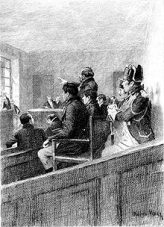
The Troyes Assizes
A conclusion, twenty-six years later, in 1832, reveals Fouché’s calculations and gives the secret of the drama, which is at the same time the secret of the kidnapping of Senator Clément de Ris and the explanation of the execution of the Duc d’Enghien. Why these changes? Balzac later justified this by explaining that the most dramatic reality never offers as much pathos and suspense as the novel. The novelist, he says, has the right to modify it to make it more moving. It’s only through this transposition that his novel becomes a genuine page of history. These two concerns may seem different, but in reality they are quite similar. Why falsify dates? because we need to make the Simeuse twins interesting by making them heroic. Three innocent convicts taken at random are only victims. They’re only interesting if you know about them. We only get to know them, and take an interest in them, if they represent something moving: in this case, loyalty to the king, loyalty all the same. Hence the link with the Polignac and Rivière conspiracy, dramatic in itself because of the memory of Cadoudal and Pichegru. Hence the date of the first episode, which shows characters typical of the “resistance” to Bonaparte, i.e. a certain historical spirit of those years. At the same time, this first episode shows a failure on the part of Fouché’s secret agent, Corentin, who was unable to intercept the Simeuses on their way to Paris, and who therefore has revenge to take on them and those who helped them, Laurence de Cinq-Cygne and Michu. Why the change in the pick-up date? Because it allows Corentin to take revenge, it’s the dramatic element. At the same time, however, it reveals a historical antagonism between the buyers of national property, who were necessarily linked to the new regime, and the former owners of these estates, who were necessarily supporters of the “resistance” and the restoration of royalty. The kidnapping of Senator Clément de Ris, if its sole purpose is to recover compromising documents for Talleyrand and Fouché, is merely an episode that has no organic link with the arrest and trial of the de Simeuse twins. Authentic reality blends events that are foreign to each other, and therefore provides no dramatic unity, just as it involves only anecdote, not a vision of history. For the two events, the kidnapping and the trial of the gentlemen, to be linked, the kidnapping must appear as revenge or blackmail on the part of the robbed family. Hence the transformation of the colorless Clément de Ris, who hasn’t robbed any powerful family, but is simply a fearful, bored high character who understands nothing, and is all the more embarrassed because he himself had already destroyed the documents his captors were looking for: In his place, Balzac invents a Malin de Gondreville, also a senator, but devious, greedy, implacable, who has seized the immense estate and quasi-royal forest that belonged to the Simeuses, and who will only have full possession of the goods he has acquired if he gets rid of the legitimate heirs. Malin de Gondreville’s hatred of the Simeuses is both a dramatic element, unifying the dual action, and at the same time a historical contrast that places typical post-revolutionary characters opposite each other: the profiteers of the new regime, buyers of national property with a local clientele, and the former masters with their former servants as accomplices.
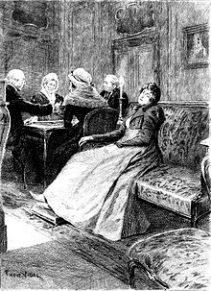
Château de Cinq Cygne
Balzac’s plot thus becomes both a dramatic duel and a page of history, showing lives endangered by the passions of the times and typical characters representing these passions born of recent events. This is exactly the definition given by Balzac in Scènes de la vie politique, “personified affections, the resistances of the moment represented by men…the contrasts produced by particular interests mingling with the general interest”. And the denouement also shows what it foretold, an example of the “appalling movement of the social machine” that crushes private lives that happen to stand in the way of the passions stirred up by events. This is exactly what Walter Scott, Balzac’s first role model, wanted to do when he portrayed in Cedric the Saxon, in Ivanhoe, in the “Puritans of Scotland” the most representative characters in the dramas of English history. This result is achieved at the cost of a few blunders, the most serious of which is the coincidence on which the whole trial is based, the fact that the kidnapping occurs, by chance and without the police being able to know it, during the night when the Simeuses and Michu have no alibi. These burrs are of little importance. What readers retain from this admirable detective novel, one of Balzac’s finest works, is the memory of one of his most moving female characters, Laurence de Cinq-Cygne, so pure, so implacable, so tender, who would later provide Claudel with his Comtesse Sygne de Coûfontaine in theHostage. It’s also a poem of loyalty and intransigence. These fighters of the night, all sublime, all driven by the same spirit of sacrifice, “subjects” of the de Simeuse family as one is a “subject” of a secret homeland, are too close to the romance of our time for today’s readers not to be as moved by them as Balzac’s readers, who remembered the still close dramas of the Revolution and the Chouannerie.
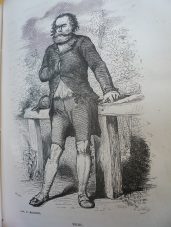
Michu
Work dated by Balzac Paris, January 1841.
Source analysis/history: Preface compiled from the complete works of the Comédie Humaine (volume XVIII) published by France Loisirs 1985 under the auspices of the Société des Amis d’Honoré de Balzac.
The characters MICHU: Intendant of the Simeuse, guillotined in 1806. His son François, born in 1793, became a public prosecutor in Arcis. François marries a Girel. SIMEUSE (de): “Ximeuse is a fiefdom in Lorraine. The name was pronounced Simeuse. This family included a Marquis de Simeuse who married a widowed Cinq-Cygne under Louis XIV. Two sons, one a vice-admiral, the second Jean, married Berthe de Cinq Cygne. They were both executed in 1792. This union produced twin brothers, Marie-Paul and Paul-Marie, born in 1773. Both killed in 1808(See Une Ténébreuse Affaire). CINQ-CYGNE: (Duinef de) Noble family from Champagne, represented by : A Cinq-Cygne widow, who married a Simeuse under Louis XIV; Berthe de Cinq-Cygne married Jean de Simeuse, producing twin sons Marie-Paul and Paul-Marie; A Comte de Cinq-Cygne, Berthe’s brother, died before 1789, leaving a widow who died in 1793 and two children: Jules, killed in the Princes’ army, and Laurence, born in 1781, who married Adrien de Hauteserre, who took his name: Berthe, who married Georges de Maufrigneuse, and Paul, deputy of Arcis. MALIN DE GONDREVILLE: Malin de L’Aube, then Count Malin de Gondreville, was a politician born in 1759 (see Ténébreuse affaire; Paix du ménage). Marries a Sibuelle, daughter of a rather disreputable supplier. They had a son, Charles, a soldier killed in 1823, who had a natural son by Madame Colleville; a daughter Cécile who married François Keller, a liberal deputy and later Count and Peer of France; and another daughter who married the Duc de Carigliano. CORENTIN: Policeman, born around 1777. MARTHE: Michu’s wife (died 1806).
Source genealogy of characters: Félicien Marceau “Balzac et son monde” Gallimard.
No Comments